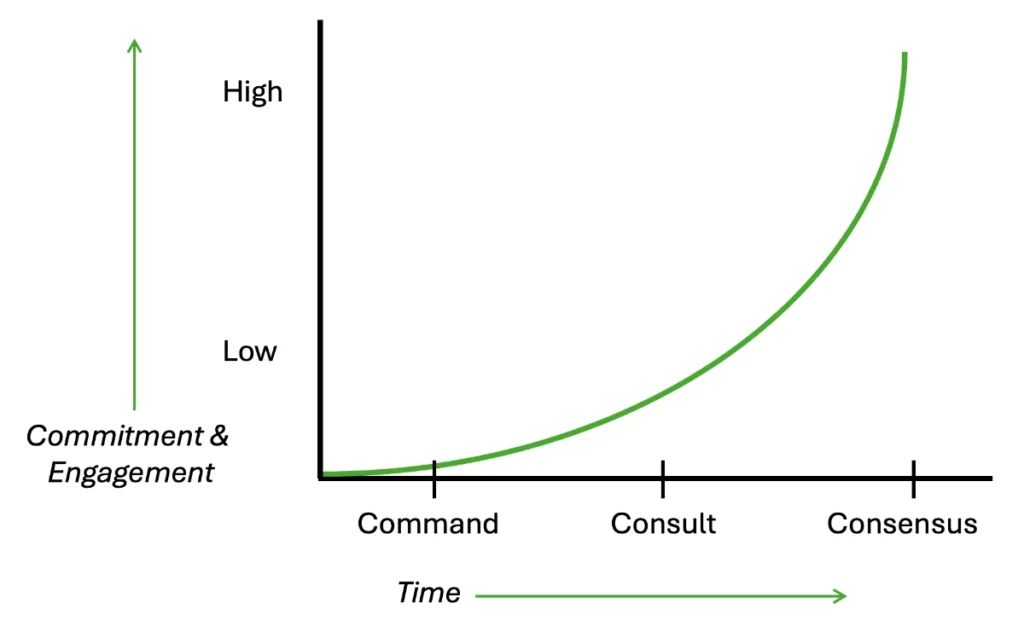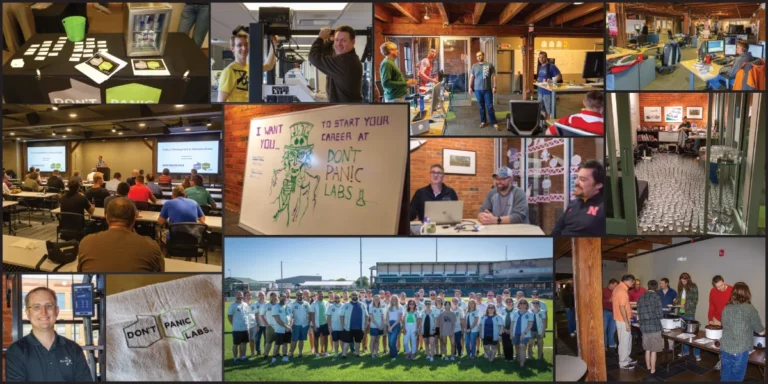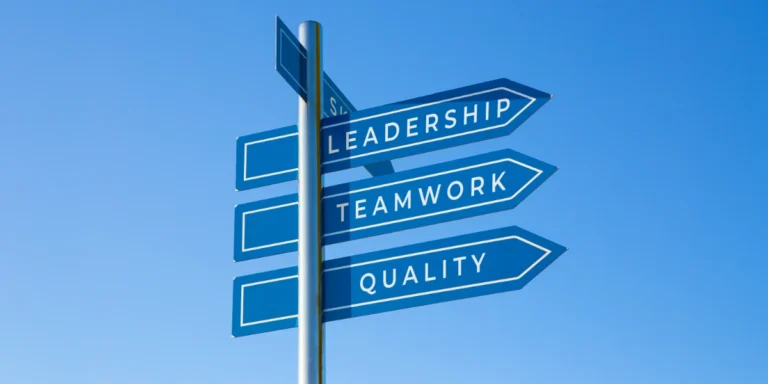
A Model for Team Decision-Making
Every day, we face many different decisions. Some are small, while others have the potential to impact the course of our lives. We strive to make the best decisions we can and in the most efficient ways possible.
Much of what I learned in college regarded making decisions as an individual—seeking out information, weighing pros and cons, performing ROIs, thinking about effects from different perspectives and time horizons, and ultimately picking a direction. However, in a collaborative world, these methods don’t go far enough in telling us how to effectively interact with others during the decision-making process.
During some leadership mentoring, I was introduced to a simple and effective model of decision-making that finally gave name to things I’d experienced and became a tool to work with my team. It is called Command, Consult, and Consensus decision-making.
In this model, there’s a spectrum of three types of team decision-making:
- Command – An empowered leader sees a decision to be made, makes it on their own, and communicates it to affected parties.
- Consult – An empowered leader sees a decision to be made, consults with other involved parties to gain their perspective, and ultimately makes the decision and communicates it.
- Consensus – A leader sees a decision to be made, brings the group of affected parties together, and all parties work together until they reach a consensus on the decision to be made.
As you move from command to consensus decision-making, it’s pretty intuitive that the amount of time needed to make a decision increases. What isn’t immediately obvious, however, is that the buy-in gained from the larger team increases as well. Here’s a visual to illustrate.

As I’ve worked to apply this method internally, I’ve discovered a couple of keys to success:
- Pick the right method of decision-making for the decision at hand.
- Share the method of decision-making with all involved parties.
- Leverage co-creation methods to help achieve consensus decision-making.
- Consider using “consult” as a fallback for consensus decision-making.
Picking the Right Decision-Making Method
Leaders often make the mistake of jumping to decision-making without considering how the decision will be made. It’s no surprise we’re under pressure to move fast and create value. Unfortunately, choosing the wrong method leads to a variety of undesirable outcomes: sub-optimal decisions, poor outcomes, frustrations from team members, and potentially the erosion of trust and disengagement of a team.
Thankfully, a little bit of critical thought goes a long way to making an effective decision and preventing these problems.
Here are some general reasons you might choose each of the following methods. Like any engineering problem, tradeoffs are involved. No individual decision situation will meet all of the reasons listed.
- Command – The primary reasons this method is selected is to prioritize the speed of decision-making or to give focus to the surrounding team by not disturbing them with it. These situations tend to have low risk, highly available information, confidence in the outcome, fit within well-defined criteria, are time-sensitive, prioritize narrowing of field of view for team members, and/or this method of decision-making is an established norm or expected by others.
- Consult – The primary reason for selecting this method is to leverage others while balancing time to make the decision. These situations tend to be less clear, benefit from ideation and information gathering, may be more controversial, and/or benefit from additional commitment from others.
- Consensus – The primary reason for selecting this method is to gain the full commitment of everyone involved. It shares many of the same motivations as Consult, but the overriding reason for selecting Consensus is identifying that a better decision will be made and all involved are critical to ensuring the success of the decision.
Sharing the Method of Decision-Making
Different situations call for different methods of making decisions. For a specific situation, it may not be immediately obvious to all involved which method is being used and why it has been selected. If your team uses a variety of methods, it can even come across as whiplash to the rest of the team.
The foundation for success is having a shared language for talking about how to make a decision (i.e., Command, Consult, Consensus) for all involved. When we rolled out this framework internally, it provided our team a powerful way to communicate about what they were experiencing and increase their understanding of the methods and tradeoffs. Second, a leader should share how a decision will be made to minimize individuals feeling “left out” or surprised.
Leverage Co-Creation for Consensus Decision-Making
One of the frequent criticisms of consensus decision-making is the amount of time involved and past frustrations trying to bring a group to consensus. Often, I’ve found this to happen when the team doesn’t know how to productively explore a situation together. This can lead to shouting matches, feelings of not being heard, and ultimately a stalemate.
To counter this, someone on the team needs to employ structured and collaborative group activities (or co-creation). These activities focus on:
- separating individuals from ideas
- making sure everyone has ample context and shared understanding
- ensuring all voices contribute their perspectives
- encouraging the generation of new possibilities (divergent thinking)
- balancing that with logical evaluation of concepts (convergent thinking)
It is also helpful for individuals to realize thinking patterns and how they are engaging with the larger group. Adam Grant has a great framework in his book Think Again, where he discusses the roles of Preacher, Prosecutor, Politician, and Scientist that can be helpful for individuals as we work towards using a Scientific mindset.
One might also frame a decision as an “Experiment” to be monitored and re-evaluated. When the weight of a “final decision” is lessened, people are more likely to explore divergent possibilities and move forward (with consensus) in a way that can be objectively re-evaluated later.
Consider Consult as a Fallback to Consensus
Even when leveraging co-creation techniques, it still may not be possible to bring a group to consensus. In situations where consensus is desirable but there is time sensitivity, a leader might inform the group ahead of time that they’re going to strive for consensus, but if consensus is not reached in a certain period of time, the leader will make the decision based on conversations. This way, it does not come as a surprise when the leader makes a decision, and the company can ultimately move forward with the benefits of a consult decision.
Final Thoughts
As you face your next team-based decision, I hope you consider implementing some of the suggestions in this post. You can always start with a small first step. By simply outlining how a decision will be made, you can achieve a lot of benefits. Introducing the concept of Command, Consult, and Consensus to your team is another step. And finally, you can frame using this model as “an experiment” to create psychological safety for your team and invite collaboration and feedback.



